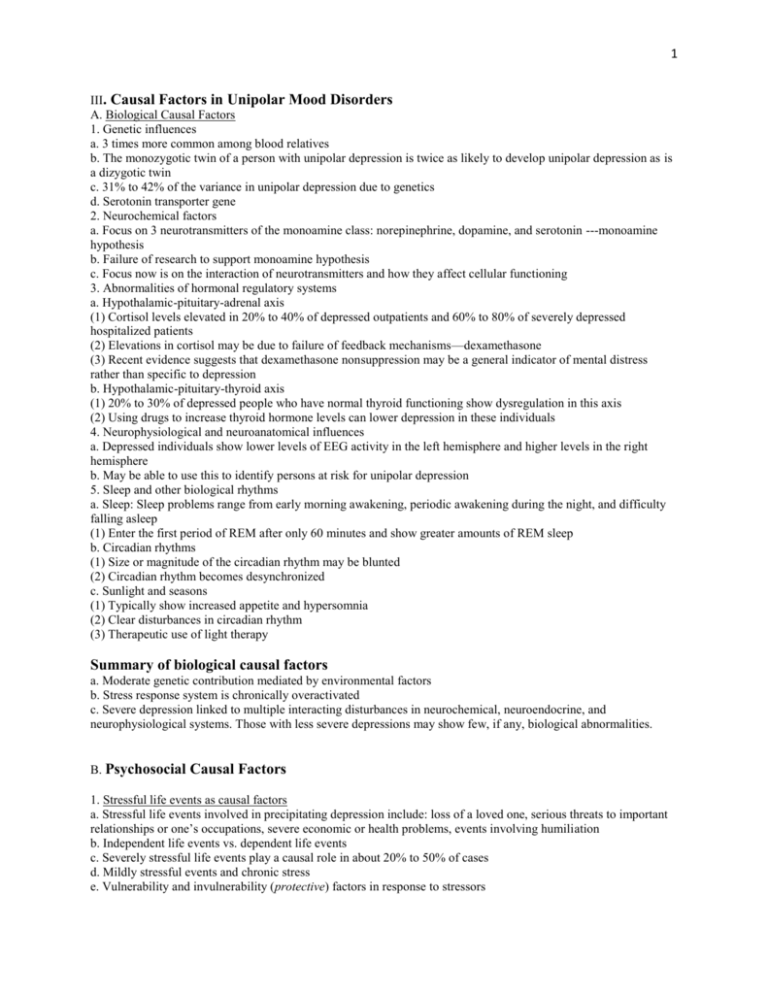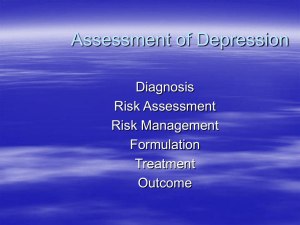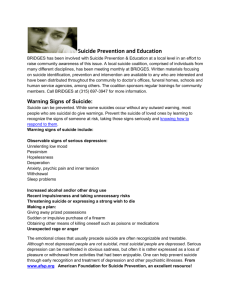1 III. Causal Factors in Unipolar Mood Disorders A. Biological
advertisement

1 III. Causal Factors in Unipolar Mood Disorders A. Biological Causal Factors 1. Genetic influences a. 3 times more common among blood relatives b. The monozygotic twin of a person with unipolar depression is twice as likely to develop unipolar depression as is a dizygotic twin c. 31% to 42% of the variance in unipolar depression due to genetics d. Serotonin transporter gene 2. Neurochemical factors a. Focus on 3 neurotransmitters of the monoamine class: norepinephrine, dopamine, and serotonin ---monoamine hypothesis b. Failure of research to support monoamine hypothesis c. Focus now is on the interaction of neurotransmitters and how they affect cellular functioning 3. Abnormalities of hormonal regulatory systems a. Hypothalamic-pituitary-adrenal axis (1) Cortisol levels elevated in 20% to 40% of depressed outpatients and 60% to 80% of severely depressed hospitalized patients (2) Elevations in cortisol may be due to failure of feedback mechanisms—dexamethasone (3) Recent evidence suggests that dexamethasone nonsuppression may be a general indicator of mental distress rather than specific to depression b. Hypothalamic-pituitary-thyroid axis (1) 20% to 30% of depressed people who have normal thyroid functioning show dysregulation in this axis (2) Using drugs to increase thyroid hormone levels can lower depression in these individuals 4. Neurophysiological and neuroanatomical influences a. Depressed individuals show lower levels of EEG activity in the left hemisphere and higher levels in the right hemisphere b. May be able to use this to identify persons at risk for unipolar depression 5. Sleep and other biological rhythms a. Sleep: Sleep problems range from early morning awakening, periodic awakening during the night, and difficulty falling asleep (1) Enter the first period of REM after only 60 minutes and show greater amounts of REM sleep b. Circadian rhythms (1) Size or magnitude of the circadian rhythm may be blunted (2) Circadian rhythm becomes desynchronized c. Sunlight and seasons (1) Typically show increased appetite and hypersomnia (2) Clear disturbances in circadian rhythm (3) Therapeutic use of light therapy Summary of biological causal factors a. Moderate genetic contribution mediated by environmental factors b. Stress response system is chronically overactivated c. Severe depression linked to multiple interacting disturbances in neurochemical, neuroendocrine, and neurophysiological systems. Those with less severe depressions may show few, if any, biological abnormalities. B. Psychosocial Causal Factors 1. Stressful life events as causal factors a. Stressful life events involved in precipitating depression include: loss of a loved one, serious threats to important relationships or one’s occupations, severe economic or health problems, events involving humiliation b. Independent life events vs. dependent life events c. Severely stressful life events play a causal role in about 20% to 50% of cases d. Mildly stressful events and chronic stress e. Vulnerability and invulnerability (protective) factors in response to stressors 2 (1) Vulnerability factors (a) Lack of close relationships (b) Having 3 children under 5 at home (c) Not having a job (d) Death of parent before age 11 (2) Invulnerability factors (Protective factors) (a) Intimate relationship (b) No more than 3 children at home (c) Having a job outside the home (d) Having a serious religious commitment 2. Different types of vulnerabilities for unipolar depression a. Personality and cognitive diathesis (1) Neuroticism (2) Introversion (3) Negative patterns of thinking: internal, stable, and global b. Early adversity and parental loss as a diathesis (1) Parental loss when followed by poor care (2) Early environmental adversity such as abuse, family turmoil, parental psychopathology, etc. (3) Can lead to “stress inoculation” if adversity is moderate rather than severe and mediated by strengthening socioemotional and neuroendocrine resistance c. Summary of different types of vulnerabilities 3. Psychodynamic theories a. 1917—Mourning and Melancholia b. Regression to the oral stage followed by incorporation of the lost person—anger turned inward c. Later psychodynamic theorists such as Klein and Jacobson emphasized the quality of the early mother-infant relationship d. Bowlby—attachment theory 4. Behavioral theories a. Depression occurs when an individual’s responses no longer produce positive reinforcement or when the rate of negative reinforcement increases b. Not very influential as an etiological theory 5. Beck’s cognitive theory (See figure 7.4 for a model of Beck’s Cognitive Model of Depression) a. Depressogenic schemas / Dysfunctional beliefs (1) Beliefs predispose a person to depression (2) Develop during childhood and adolescence as a function of one’s negative experiences with parents and significant others (3) Activated by current stressors or depressed mood creating a pattern of negative automatic thoughts (4) Negative cognitive triad: self, one’s experiences and the surrounding world, one’s future (see figure 7.5 for model of the negative Cognitive Triad) b. Negative cognitive biases or errors maintain the negative cognitive triad (1) Dichotomous or “all or none” reasoning (2) Selective abstraction (3) Arbitrary inference c. Evaluating Beck’s theory as a descriptive theory (1) Nondepressed people show a large positivity bias in attributions (2) Stressors are not necessary to activate negative cognitive triad; simple depressed mood can activate negative cognitive triad (3) Teasdale—vicious cycle of depression d. Evaluating the causal aspects of Beck’s theory (1) Results mixed (2) Recent studies suggest that those with high levels of dysfunctional attitudes and high stress are more likely to develop major depression than those with low stress or low dysfunctional attitudes and high stress 6. Interpersonal effects of mood disorders 3 a. Lack of social support and social skills deficits b. The effects of depression on others c. Marriage and family life (1) High correlation between marital dissatisfaction and depression (2) Marital distress increases relapse for depression (3) Parental depression increases problems for children SUICIDE A. General Information 1. Depressed individuals are 50 times more likely to commit suicide than nondepressed individuals 2. Ranks among the 10 leading causes of death in most Western countries 3. 40% to 60% of those who complete suicide do so during a depressive episode or in the recovery phase 4. Most people who commit suicide are ambivalent and are alone and in a state of severe psychological distress and anguish B. The Clinical Picture and the Causal Pattern 1. Who attempts and who commits suicide? (See figure 7.10 for chart of US suicide rates by age, gender, and race) a. Until recently the peak age for suicide attempts was 25–44 years; now the peak age is 18–24 with four times as many men as women dying from suicide b. Highest rate of completed suicides is in the elderly (65 and over) c. Methods of suicide vary between the genders d. High risk groups include the depressed, those suffering from schizophrenia, alcoholics, divorced persons, certain professionals (highly creative or successful scientists, physicians and psychologists, businessmen, composers, writers, and artists), people living alone, and people from socially disorganized areas 2. Suicide in children a. Rates have been increasing b. Increased 70% for children aged 5–14 since 1981 c. Increased risk if child has lost a parent or has been abused 3. Suicide in adolescents and young adults a. Third most common cause of death in 15–24 b. Second leading cause of death among college students c. Increases in suicide rates for adolescents observed worldwide d. Known risk factors for adolescent suicide (1) Mood disorder, conduct disorder, and substance abuse (especially alcohol) (2) Treatment with antidepressants (3) Media exposure to suicides (4) For college students, the combined stressors of academic demands, social interaction problems, and career choices 4. Other psychosocial factors associated with suicide a. A variety of situational factors can trigger suicide b. “Success suicides” can be seen following positive life events c. Hopelessness about the future may be a good predictor of suicide within one to two years d. Predictors of immediate suicide among the depressed: severe psychic anxiety, panic attacks, severe anhedonia, global insomnia, delusions, and alcohol abuse e. Schneidman—suicide is an escape from pain f. Psychosocial causes: combination of family psychopathology, child maltreatment, and family instability associated with low self-esteem, hopelessness, and poor problem-solving skills 5. Biological causal factors a. Concordance rate in monozygotic twins about 19 times higher than in fraternal twins b. Reduced serotonergic activity 6. Sociocultural factors a. Whites have much higher suicide rates than African Americans except among young males where rates are similar b. Rates vary from one society to another (Hungary is the highest) c. Religious beliefs are important determinants of suicide rates (Catholics and Muslims are low) d. Japan is one culture that sanctions certain suicides; Muslim extremists are another 4 e. Subgroup differences exist within societies f. Durkheim’s view of group cohesiveness as a factor in suicide C. Suicidal Ambivalence 1. Ambivalence a. Some wish to communicate a message to others b. Some are seemingly intent on ending their lives c. Some are ambivalent and leave death to chance d. Following an attempt there is a reduction in emotional turmoil 2. Communication of suicidal intent a. 40% communicate suicidal intent in very clear and specific terms; an additional 30% had talked about death and dying b. 50% had never seen a mental health professional c. Among inpatients hospitalized for suicidal ideation or intent, nearly 80% denied suicidal ideation the last time they spoke with a clinician 3. Suicide notes a. Only about 15% to 25% leave notes b. Suicide notes are typically coherent and legible; some include statements of love and concern; occasionally suicide notes contain very hostile content c. Most notes do not provide significant insights into the suicidal mind









